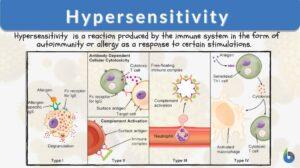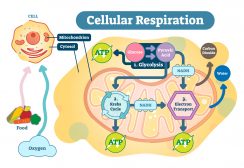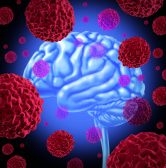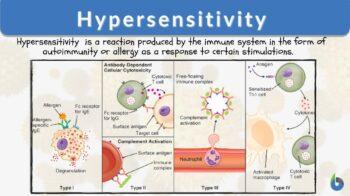
Hypersensitivity
n., plural: hypersensitivities
[ˈhaɪpə(ɹ)/ ˈsɛnsɪvəti]
Definition: Exaggerated immune response to a foreign substance
Table of Contents
Hypersensitivity Definition
Hypersensitivity is the exaggerated immune response to protect the human from foreign bodies known as antigens. When the antigen is detected by the immune system, a hyperimmune response starts and the hypersensitivity reaction starts. This reaction is not always desirable as it may harm humans. Hypersensitivity reactions may lead to various consequences ranging from mild symptoms to severe shock causing death. Antigens or causative agents may be either small particles such as pollen grains or large particles such as drugs including antibiotics. Antigens are detected by T cells or antibodies by recognizing epitopes on the surface of the antigen. Some antigens may have the same epitope, so antibodies are able to detect more than one antigen with the same epitope and interact with them. This phenomenon is known as cross-reactivity.
Gell and Coombs were the first scientists to define hypersensitivity reaction. Gell and coombs classified hypersensitivity into 4 stages of anaphylaxis and numerous types depending on the affected part of the body. Several types of hypersensitivity reactions may affect the body such as:
- Dentin hypersensitivity: it is hypersensitivity of the teeth. Dentinal pain is one of the most annoying types of pain. Education of patients to avoid risk factors such as avoiding acidic foods, brushing teeth frequently, and using desensitizing toothpaste is dentin hypersensitivity treatment guidelines.
- Electromagnetic hypersensitivity: it is a case in which some people experience hypersensitivity during exposure to electromagnetic fields.
- Visceral hypersensitivity: this type of hypersensitivity is associated with pain in the viscera part “inner parts“. This refers specifically to irritable bowel syndrome.
- Carotid sinus hypersensitivity: Carotid baroreceptors which are located in the neck control heart rate. Therefore, carotid sinus hypersensitivity leads to a drop in heart rate and blood pressure. It is mainly observed elderly suffering from atherosclerotic diseases.
- Seminal plasma hypersensitivity: the hypersensitivity occurs after exposure to protein components in the plasma of Semin. Prostate-specific antigen is the major protein that stimulates this reaction.
- Auditory hypersensitivity: it is a case in which some people are confused when hearing specific sounds or noise. This can be referred to as sensitivity to noise anxiety.
- Sensory hypersensitivity: it is a sensitivity to the stimulation of any of the five senses such as Hypersensitivity to smells and Tactile hypersensitivity when the person is sensitive to touch.
- Emotional hypersensitivity: an emotionally hypersensitive person is highly sensitive to emotional situations that the person may suffer from hypersensitivity symptoms as a result.
- Reflux hypersensitivity: is a disorder of the esophagus. The main symptoms are heartburn, esophagitis, and chest pain.
Hypersensitivity is a state of altered reactivity in which the body reacts with an exaggerated immune response to a foreign substance. Hypersensitivity reactions are classified as immediate or delayed (Type I and Type IV, respectively, in the Gell and Coombs classification of immune responses).
Gell and Coombs Classification
Gell and coombs are British scientists who published a book in 1963 describing the classification of hypersensitivity disorder. Gell and coombs classified the reaction into 4 types of hypersensitivity according to the difference in the latency; the following are types of hypersensitivity reactions (or types of immune responses):
- Type 1 hypersensitivity: it is an immediate type as physiological symptoms appear within seconds to minutes.
- Type 2 hypersensitivity: it is called cytotoxic hypersensitivity. Its symptoms appear within minutes to hours.
- Type 3 hypersensitivity: this type is an immune complex-mediated type where symptoms appear within several hours.
- Type 4 hypersensitivity: it is a delayed allergic reaction. As it occurs after hours to days for symptoms to appear which is a long time for response.
Although there are 4 different types of allergic reactions, there is only one ICD-10 (International Classification of Diseases 10th Revision) code for anaphylaxis, which is T78.00XA in 2022.
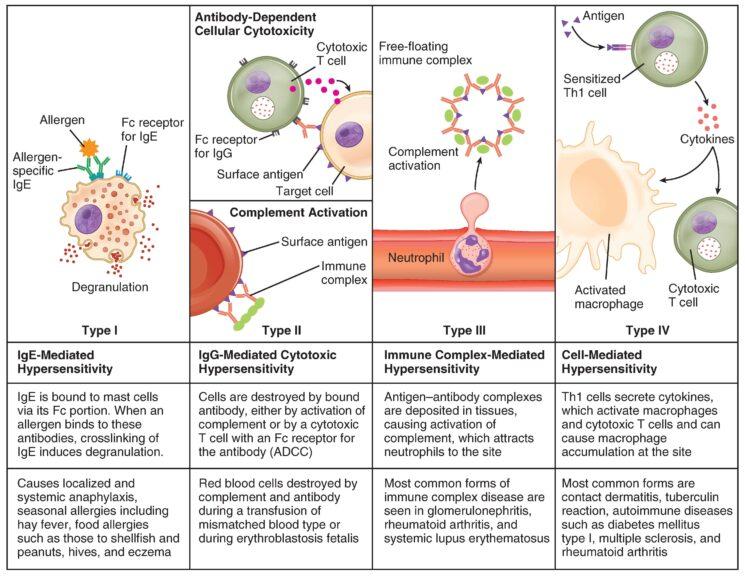
Type I Hypersensitivity
Type 1 hypersensitivity occurs within seconds to minutes. Therefore, it is called immediate hypersensitivity. Generally, this type is not harmful, however, the antigen in this reaction may be either harmless as pollen grain, drugs, and food or harmful antigen as venoms. Symptoms of the reaction may affect any part of the body such as the following hypersensitivity examples:
- Rhinitis: allergy in the nose.
- Conjunctivitis: it is an ocular allergy.
- Dermatological allergy: hypersensitive skin suffers from dermal hypersensitivity reactions like eczema.
Etiology
The main antibody exaggerated by the immune response during this reaction is called immunoglobulin E (IgE) which attacks soluble antigens. The interaction between IgE and the antigen releases histamine and inflammatory mediators.
There are two stages of this immune response after exposure:
- First stage, called the sensitization stage, is where the host contacts the antigen for the first time. This contact is asymptomatic as the host recognizes the antigen for the first time.
- Second stage is the late phase reaction at which the sensitized host is exposed to the antigen again leading to the development of type I hypersensitivity reaction.
Types of antigens involved
What causes hypersensitivity? There are various types of antigens that can exaggerate the immune response such as:
- Food: some foods may cause allergies like Nuts, Soy, and wheat.
- Animal source: Bee bites, cats, and rat dender
- Environmental source: Dust, pollen, and molds.
- Drug allergy: antibiotics are the main drugs that induce allergic reactions. However, other such as propofol and isoflurane anesthesia drugs may induce hypersensitivity as well.
Type II Hypersensitivity
This reaction occurs within about 24 hours. It is known as cytotoxic type as the main antibodies directed to the cellular antigens are IgE and IgM. This interaction damages the cell, affecting its function, and damaging tissues. This interaction takes place by three mechanisms:
- Antibodies can alter the activity of the cell by binding to its receptors
- Antibodies can also activate the complement pathway
- Induce their cytotoxic effect on the cell leading to its death
What is immune tolerance? Immune tolerance is a phenomenon in which the immune system can detect antigens of the body and recognize them as self-antigens. self-antigens are not attacked by the immune system, So the immune system does not produce antibodies against them.
In type 2 hypersensitivity, self-antigens on the cell surface may be changed and modified by their contact with the external antigen. Thereafter, the self-antigen turns into an antigenic epitope that can be detected and attacked by the immune system. Some medications are the most common cause of type 2 hypersensitivity such as penicillin, methyldopa, and cephalosporins. These medications break down the immune tolerance of the cell as the drug binds to the cells changing self-antigens into epitopes.
Type III Hypersensitivity
Type 3 hypersensitivity is an immune complex-mediated reaction. In this reaction, an antibody-antigen complex is formed. This aggregation can be precipitated in different tissues leading to the activation of the complement pathway. When the complement pathway is activated, inflammatory cells such as monocytes and neutrophils are recruited to the complex site. Lysosomal enzymes that damage cells are released by monocytes and neutrophils. This damage takes place in three stages which are:
- Immune complex formation: at this stage, the antigen is detected by the antibody and interacts with it forming an immune complex.
- Immune complex deposition: the antigen-antibody complex precipitates in joints and glomeruli of the kidney. This occurs when the ratio of antigens is higher than that of antibodies.
- Inflammatory reaction: the classical pathway begins when the complex is precipitated which leads to the release of C3a, C5a, macrophages, and neutrophils. The release of these mediators damages tissue. hypersensitivity symptoms differ according to the site of inflammation; it is presented as arthritis when the inflammation is at joints and glomerulonephritis when glomeruli are inflamed.
Serum sickness bee sting is an allergic reaction but less dangerous and slower than anaphylaxis. when a bee stings a human, it releases its toxins in the blood and causes serum sickness which can be observed within a few days to weeks
Serum sickness, rheumatoid arthritis, and systemic lupus erythematosus are the most common diseases as a result of type 3 hypersensitivity.
Type IV Hypersensitivity
Type 4 hypersensitivity is considered as delayed anaphylaxis in which the T-cells play the main role. The reaction happens as follows:
- The body is exposed to the antigen.
- Leukocytes are attracted to the antigen.
- Macrophages engulf the antigen.
- Monocytes are presented to T-cells.
- T-cells begin to be activated and sensitized.
- T-cells begin to secrete cytokines and chemokines.
- Tissue damage occurs.
There are four subtypes of type 4 hypersensitivity reaction; IVa, IVb, IVc, and IVd. These subtypes are dependent on the type of T-cells included in the reaction. Delayed reaction is important for the protection of the body against pathogens, such as mycobacteria and certain fungi, and tumors.
Pathophysiology
The causative agent is responsible for the pathophysiology of type 4 hypersensitivity. It is subdivided according to pathophysiology into three types with three different mechanisms. As with granulomatous disease, T-cells are activated by antigens engulfed by macrophages, which are antigen-presenting cells. Macrophages then secrete a large number of cytokines such as interleukin 2 (IL-2) and tumor necrosis factor with its two types — alpha and beta. Macrophages then turn into multinucleated cells and increase in size.
A hapten is not immunogenic alone, however, contact dermatitis takes place when the hapten is coupled with an antigen and applied to the skin directly. This complex is presented to T-Cells stimulating the immune response which results in irritating the skin by the production of inflammatory mediators such as ICAM-1, ELAM-1, and VCAM-1. CD4 and CD8 are the main immunological T-cells involved in the reaction. The third type is the tuberculin test type which is used for the diagnosis of tuberculosis. Tuberculin type 4 hypersensitivity is an allergic reaction to TB test. Tuberculin is a purified protein derivative that is injected intradermally. The injection causes swelling in the site of injection after 48 hours to 72 hours.
Treatment/Management
These treatments are for information purposes only and should not be taken without prior medical advice. Seek medical help to know the best therapeutic approach to treating or managing hypersensitivity.
Immediate hypersensitivity reactions
Anaphylaxis which is associated with type 1 hypersensitivity should be controlled immediately. The common treatments are as follows:
- Adrenaline intramuscular injection is the first line to manage anaphylaxis.
- Oxygen support must be included if anaphylaxis is associated with bronchial asthma since it may lead to respiratory collapse and death. In Addition to oxygen therapy, Inhaled bronchodilators such as salbutamol with inhalation of corticosteroids can be used to manage asthma symptoms.
- Using antihistaminic drugs by intravenous injection.
- Adjust blood pressure by using IV fluids.
- Methotrexate and Omalizumab can be used in low doses.
Delayed hypersensitivity reactions
Delayed hypersensitivity treatment depends on the causative agent:
- Contact dermatitis: it is a subtype of type 4 hypersensitivity and happens when the antigen is in direct contact with the sensitive skin. The treatment scheme is often by the use of topical steroids and may use oral antihistamine drugs such as chlorpheniramine, which is a rapidly acting antihistamine.
- Granulomatous allergy: one of the granulomatous diseases is sarcoidosis with both types; ocular and systemic. The first line for sarcoidosis is steroids as well as methotrexate, which may be used as adjuvant therapy.
- If a tuberculin test is positive, the best treatment is to begin a tuberculosis regimen which includes rifampin, pyrazinamide, and isoniazid.
- Schistosomiasis can cause anaphylaxis, the best management often entails the use of praziquantel drugs.
Try to answer the quiz below to check what you have learned so far about hypersensitivity.
Further Reading
References
- 2022,2022 ICD-10-CM Diagnostic Code T78.00XA. 10. (n.d.). Retrieved April 2, 2022, from https://www.icd10data.com/ICD10CM/Codes/S00-T88/T66-T78/T78-/T78.00XA
- Abbas, M. (2021, July 21). Type I hypersensitivity reaction. StatPearls [Internet]. Retrieved April 1, 2022, from https://www.ncbi.nlm.nih.gov/books/NBK560561/
- Bajwa, S. F. (2021, September 20). Type II hypersensitivity reaction. StatPearls [Internet]. Retrieved April 1, 2022, from https://www.ncbi.nlm.nih.gov/books/NBK563264/#article-30714.s2
- Barbara Bolen, P. D. (2020, October 24). Teach the biology behind your awful ibs pain. Verywell Health. Retrieved April 2, 2022, from https://www.verywellhealth.com/visceral-hypersensitivity-1945074
- Contributors, W. M. D. E. (n.d.). Bee Sting serum sickness: Causes, symptoms, and treatment. WebMD. Retrieved April 2, 2022, from https://www.webmd.com/allergies/what-is-bee-sting-serum-sickness
- Dieudonné, M. (2020, May 6). Electromagnetic hypersensitivity: A critical review of explanatory hypotheses – environmental health. BioMed Central. Retrieved April 2, 2022, from https://ehjournal.biomedcentral.com/articles/10.1186/s12940-020-00602-0
- Frank, S. A. (1970, January 1). Specificity and cross-reactivity. Immunology and Evolution of Infectious Disease. Retrieved April 2, 2022, from https://www.ncbi.nlm.nih.gov/books/NBK2396/
- Homepage – citation machine – plagiarism and grammar checker. (n.d.). Retrieved April 1, 2022, from https://writing.citationmachine.net/edit/7d96ea1b-78b0-4a06-ac30-cee8870a3f93
- Hypersensitivity to sound and anxiety disorders: Symptoms, causes and proven solutions. Calm Clinic – Information about Anxiety, Stress and Panic. (2021, February 12). Retrieved April 2, 2022, from https://www.calmclinic.com/anxiety/symptoms/hypersensitivity-to-sound
- Hypersensitivity: Could it be sensory processing disorder? The Child Development Centre. (2018, June 26). Retrieved April 2, 2022, from https://www.thechildcentre.com/could-your-childs-hypersensitivity-be-sensory-processing-disorder/
- Marwa, K. (2021, November 7). Type IV hypersensitivity reaction. StatPearls [Internet]. Retrieved April 2, 2022, from https://www.ncbi.nlm.nih.gov/books/NBK562228/
- Marwa, K. (2021, November 7). Type IV hypersensitivity reaction. StatPearls [Internet]. Retrieved April 2, 2022, from https://www.ncbi.nlm.nih.gov/books/NBK562228/
- R;, Y. T. F. (n.d.). Reflux hypersensitivity: A new functional esophageal disorder. Journal of neurogastroenterology and motility. Retrieved April 2, 2022, from https://pubmed.ncbi.nlm.nih.gov/28992673/
- Trushkowsky, R. D. (2017, November 27). Etiology and treatment of dentinal hypersensitivity. Decisions in Dentistry. Retrieved April 2, 2022, from https://decisionsindentistry.com/article/etiology-treatment-dentinal-hypersensativity/
- UpToDate. (n.d.). Retrieved April 2, 2022, from https://www.uptodate.com/contents/carotid-sinus-hypersensitivity-and-carotid-sinus-syndrome#H3491581588
- Usman, N. (2021, August 22). Type III hypersensitivity reaction. StatPearls [Internet]. Retrieved April 1, 2022, from https://www.ncbi.nlm.nih.gov/books/NBK559122/
- Vaillant, A. A. J. (2021, November 15). Immediate hypersensitivity reactions. StatPearls [Internet]. Retrieved April 2, 2022, from https://www.ncbi.nlm.nih.gov/books/NBK513315/#article-23213.s9
- What is tactile defensiveness or touch sensory sensitivity? – by Griffinot. GriffinOT. (2022, March 3). Retrieved April 2, 2022, from https://www.griffinot.com/what-is-tactile-defensiveness/
©BiologyOnline.com. Content provided and moderated by Biology Online Editors.

